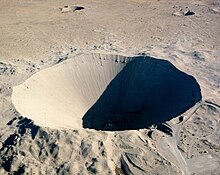Explosion crater


An explosion crater is a mostly funnel-shaped depression in the earth's surface.
There are two types of such craters:
- craters created by volcanic events of a phreatic or phreatomagmatic explosion ,
- Craters created by the explosion of a bomb or an artillery shell, often referred to as bomb or shell craters.
The impact crater caused by the impact of a celestial body is related to the explosion crater .
Volcanic explosion craters
Explosion crater is a collective name for volcanic maars , tuff rings , tuff cones or pseudo craters . They are the result of water vapor explosions ( phreatic or phreatomagmatic explosion ), in which hot magma comes into contact with water. Due to the high energy, rock and magma are very finely atomized and deposited as volcanic ash or lapilli .
One example is the explosion crater or the tuff ring of the Hverfell in Iceland .
Bomb and grenade holes


When a bomb explodes ( ground zero ), the extreme pressure of the explosion displaces the earth to the sides and upwards. A mostly circular depression is created. At the edges, part of the ejected material forms a wall, another part falls back into the crater.
Depending on the strength of the bomb or grenade, the type and moisture of the soil, the bomb or grenade funnel are of different sizes, depths and long-lasting. Today there are still numerous bomb craters from the Second World War in extensively used areas of the landscape, such as forests and pastures. Over time, small bodies of water and ecologically valuable small biotopes can develop in bomb craters on soils influenced by groundwater . An example of this is the air raid on Wangerooge on April 25, 1945. Some crater landscapes are now considered land monuments , such as areas after the battle in the Hürtgen Forest . In settlement areas or on cultivated fields, bomb craters were usually quickly filled with earth again and can only be proven archaeologically . The backfilling also took place with other available material, such as rubble and later also with municipal waste. The filling of funnels continues to this day.
In France, large parts of the battlefields of the First World War were state-owned and declared " zone rouge " (red zone). No agriculture may be carried out or built here. The aim is to leave the regions devastated mainly by artillery fire largely unchanged. The terrain of the front was literally dead after the battles and resembled a hazardous waste depot: the ground had been burned meters deep and poisoned by explosives and gas ammunition. Everywhere utensils and objects of everyday life were lying around, in between rotting corpses.
One of the largest explosion craters in Germany can be found in Prüm . It comes from the disaster of 1949 , in which an ammunition dump exploded for reasons unknown to this day and large parts of the city were destroyed.
By aerial bombs
By nuclear weapon explosion
Crater formation only occurs in the case of ground detonations or underground detonations that take place at shallow depths. At a static overpressure of about 10 GPa , craters form. The crater formation of a nuclear weapon explosion is to be exploited to remove earth walls such. B. to destroy heaped dams. The resulting shock wave in the underground is intended to destroy bunkers and missile silos .
| Explosive power | 20 kt | 100 kt | 500 kt | 4.5 Mt |
|---|---|---|---|---|
| Bomb type | Nagasaki type bomb | GB / USA Trident I | GUS SS-25 , SS-27 | China DF-5 |
| Target point deviation | several kilometers | 90 m | 350 m | 500-1500 m |
| Crater diameter 1 | 45 m | 73 m | 118 m | 228 m |
| Bunker destroyed | 56 m | 91 m | 147 m | 285 m |

One of the largest explosion craters is the crater of the Sedan experiment of Operation Plowshare on July 6, 1962 at the Nevada test site . The demolition was part of a program for the peaceful use of nuclear weapons for earthmoving work. The warhead had an explosive force of 104 kt and was detonated as an underground detonation at a depth of 193 m. The explosion moved 12 million t of earth, caused an artificial earthquake with a magnitude of 4.75 on the Richter scale and left a radioactively contaminated crater with a diameter of 390 m and a depth of 97 m, which is significantly larger than the table value. The same applies to impact craters .
Very large craters also arise on damp or soft ground. One of the largest nuclear weapon craters ever comes from the Castle Bravo test (the largest bomb set by the USA at 15 Mt) on Bikini Atoll ; its diameter is approx. 2000 m, while its depth is only approx. 80 m.
Web links
Individual evidence
- ↑ Definition of explosion crater (English)
- ↑ War- affected soils in Germany at the annual conference of the Federal Soil Association on September 18, 2014 (PDF, 2.6 MB)
- ↑ Theaters of battle today at planet-wissen.de